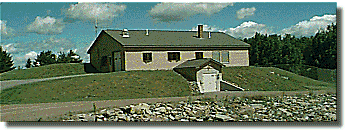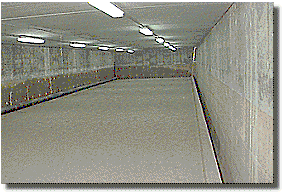|

The Milo Slow Sand
Filtration Plant was constructed to meet the standards of the Safe
Drinking Water Act Amendments of 1986. It was designed by A. E.
Hodsdon, Consulting Engineer of Waterville, Maine, built by
Brescia Construction of Clinton, Maine and funded with
assistance from Rural Development.
The filtration method chosen is termed "Slow Sand Filtration" due
to the slow rate which the water is filtered; this technology is
over 100 years old. The raw water is drawn from the Sebec River
and pumped from the Main Street pumping station to the treatment
facility. Once it reaches the treatment facility it is pretreated
by a microscreen, if needed, and then flows gravity to the filter
beds. The filter media consists of a 36 inch layer of sand, a 3
inch layer of rice stone ( 1/16 to 1/4 inches ); a 3 inch 1ayer of
pea stone (1/4 to 3}8 inches); a 3 inch 1ayer of crushed stone
(3/8 to 1/2 inches) and a 12 inch layer of crushed stone (1/2 to
3/4 inches). The filter itself provides treatment by a straining
effect, however, the filter layer of most interest is the top few
inches of sand which develops a biofilm called the "Schmutzdecke".
When a micro organism comes in contact with the sand and biofilm,
it is adsorbed and metabolized, thereby preventing its passage. In
total the treatment plant provides a triple barrier (microscreen,
sand filter, and disinfection) to prevent the passage of Giardia
bacteria and other undesirables in the water system. The filtered
water is collected by an underdrain system and is chlorinated as
it travels gravity to the reservoir. The reservoir is a concrete
tank holding 500,000 gallons of water and allowing 2 1/2 days of
detention time at average flows.

The facility is designed with 3 filter beds; each sized at 23' 8"
wide and 81' tong with each holding 50,000 gallons of water. The
center filter has a 6 inch layer of granular activated carbon
which is sandwiched 12 inches below the sand. This GAC sandwich
was installed to enhance the removal of naturally occurring
organics which contribute to reduce color and the formation of
trihalomethanes (THM's ). THM's are formed when the organic matter
reacts with chlorine used for disinfection. The GAC effectively
removes the organics before this reaction can take place.
The treated water quality is required to meet the following
Federal and State imposed Standards:
Turbidity (a measure of particles in the water): Less than or
equal to 1.0 NTU in a minimum of 95% of samples taken;
Chlorine Residual (a measure of disinfection): Greater than 0.2
milligrams per liter of Chlorine Residual.
The facility meets these requirements with ease and requires
minimal manpower to operate.
The project funding was provided through Rural Development. The
District received a grant in the amount of $1,182,700.00 and long
term low interest loans in the amount of $1,820,300.00 making a
total project cost of $3,003,000.00 This included the treatment
facility at a cost of of $1,367,020.20 plus Park Street
distribution main, pump station retrofit and a transmission main
to the treatment facility. |

